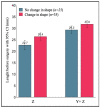Uterine Fundus Remodeling after Hysteroscopic Metroplasty: A Prospective Pilot Study
- PMID: 33445663
- PMCID: PMC7828148
- DOI: 10.3390/jcm10020260
Uterine Fundus Remodeling after Hysteroscopic Metroplasty: A Prospective Pilot Study
Abstract
The septate uterus is the most common congenital uterine malformation and is treated by hysteroscopic metroplasty. There are few studies on the fundal uterine changes that occur after surgery. We designed a pilot prospective observational study to evaluate by three-dimensional transvaginal ultrasound (3D-TVS) the changes not only of the internal fundal uterine profile, but also of the external one, after hysteroscopic metroplasty. Sixty women who underwent hysteroscopic metroplasty for partial or complete uterine septum (U2a and U2b subclasses of ESHRE/ESGE classification) were enrolled. We performed 3D-TVS after surgery confirming optimal removal of the septum. However, at ultrasound follow-up after three months, we observed a significant increase (p < 0.001) in the residual septum (Zr) (3.7 mm (95% CI: 3.1-4.4)), the myometrial wall thickness (Y) (2.5 mm (95% CI: 2.0-3.0)) and the total fundal wall thickness (Y + Zr) (6.2 mm (95% CI: 5.5-6.9)). Forty-three patients (72%) required a second step of hysteroscopic metroplasty. Moreover, the shape of uterine fundus changed in 58% of cases. We actually observed a remodeling of the uterine fundus with modifications of its external and internal profiles. Therefore, we propose to always perform a second ultrasound look at least three months after the metroplasty to identify cases that require a second- step metroplasty.
Keywords: hysteroscopy; remodeling; septate uterus; ultrasound; uterine fundus; uterine malformation.
Conflict of interest statement
The authors declare no conflict of interest.
Figures







References
-
- Grimbizis G.F., Gordts S., Di Spiezio Sardo A., Brucker S., De Angelis C., Gergolet M., Li T.C., Tanos V., Brölmann H., Gianaroli L., et al. The ESHRE/ESGE consensus on the classification of female genital tract congenital anomalies. Hum. Reprod. 2013;28:2032–2044. doi: 10.1093/humrep/det098. - DOI - PMC - PubMed
LinkOut - more resources
Full Text Sources
Other Literature Sources

